The Rise of the Varroa Mite: An Unseen Enemy
- Introduction to Varroa Mites: What Are They?
- Origin and Spread: How Did They Become a Global Threat?
- Biology and Lifecycle of Varroa Mites
- Impact on Honey Bees: Symptoms and Consequences
- Economic and Environmental Effects on the Honey Bee Industry
- Control Measures: Current Methods and Challenges
- Future Directions: Research and Hope for a Solution
WHEN BOMBAY BEEKEEPER Wright threatened to sit on his hives with a shotgun to prevent government officials destroying them, he had already made up his mind about the varroa bee mite, Varroa destructor—it was unstoppable.
It was winter 2000, and while the Ministry of Agriculture was conducting a survey to see how far the mite had spread since its discovery in April in six Auckland apiaries, John and Helen Wright were doing their own research. “We found out about varroa on the Internet and by flying to the United States to talk to beekeepers who had learned to live with it,” said John. “No one in New Zealand knew anything about it.”
It didn’t take long for everyone connected with the beekeeping industry to realise that varroa was not an enemy to be taken lightly. The mite doesn’t look especially threatening: with its eight legs and 1.1 mm by 1.6 mm flat, reddish-brown body it resembles a tiny oval crab. But it can move speedily across a honeycomb, and within the past 100 years has spread around the globe by hitching a ride on adult honeybees. Varroa researchers say that the mites are so good at jumping on board a passing bee that if they cover a hive baseboard with live mites a honeybee walking across it “vacuums” a clear path as it goes.
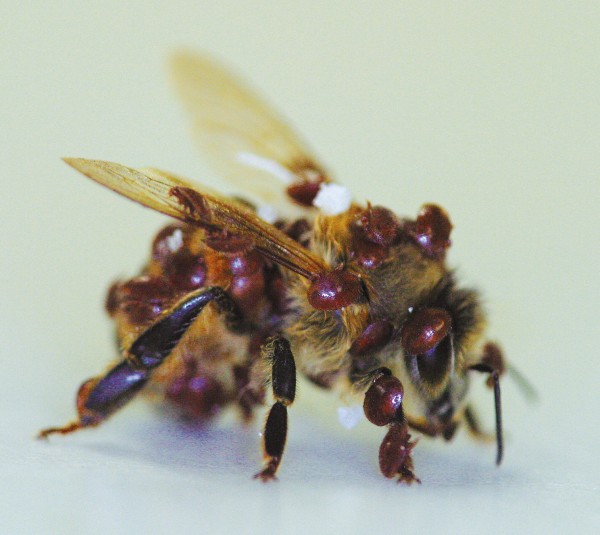 “Like having a leech the size of a tennis ball clamped onto your leg” is how one beekeeper compared the varroa mite’s depredations on honeybees. Adult bees can generally tolerate the presence of a few mites on their bodies (it is rare for there to be more than two or three mites per bee—the individual shown here was part of a laboratory study).KENNEDY WARNER
“Like having a leech the size of a tennis ball clamped onto your leg” is how one beekeeper compared the varroa mite’s depredations on honeybees. Adult bees can generally tolerate the presence of a few mites on their bodies (it is rare for there to be more than two or three mites per bee—the individual shown here was part of a laboratory study).KENNEDY WARNER
In search of a better bee
The mite was first discovered in Java in 1904 on its natural host, the Asian honeybee, Apis cerana, which is able to tolerate the parasite’s presence. By 1963, varroa had jumped species to attack the common honeybee, Apis mellifera, which has no natural defences against it, and by 1999 it had colonised every beekeeping area of the world except Australia and New Zealand, wiping out millions of bees along the way and changing beekeeping practices forever.
In 2000, New Zealand fell to the mighty mite. No one knows precisely when or how it reached these shores. What is known is that live bees are the most common vectors in the spread of varroa, yet no live bee imports into New Zealand have been permitted for at least 40 years. Varroa must therefore have arrived on queen bees illegally smuggled past our border controls, or within a feral bee colony in or on one of the 400,000 or so shipping containers which are landed in New Zealand every year.
New to NZGeo? We’re a family-owned media company focusing on New Zealand’s society and environment. We’re not too bad at it, winning Canon/Voyager Magazine of the Year in 2017, 2018, 2019, and 2020. We rely mainly on subscriptions from people like you to create these stories—in print, digital or both. If you like what we do you can start with a two-week trial for just $1.
The arrival of varroa took local beekeepers by surprise, and many unwittingly spread it right through their operation before they knew they had it. “You can’t see it in the early stages,” says Auckland apiarist Mike Stuckey. “We had some isolated hives out on the Kaipara peninsula, which I thought would take a while to get it. I was very careful what I took up there, but varroa was there by the next spring.”
Varroa’s world domination is now nearly absolute and, watching its spread on an animated map on MAF’s website, I can’t help comparing its relentless progress to that of a marching army. But for human intervention arising from the bee’s usefulness to us as a pollinator and honey-maker—Apis mellifera would be almost extinct. Australia is now the only beekeeping continent without varroa, and therefore the only continent in which the honeybee’s survival is not dependent on humans.
*
TODAY, THREE YEARS after making the shotgun threat, John Wright can laugh about it, but the fear and pressure felt by beekeepers at that time is still tangible as he and Helen recount the story. John has worked with bees for some 50 years, and takes on their quality of perpetual motion when talking about them, enthusiastically streaming from one bee-related topic to the next. Like most beekeepers I have met, he has turned a passion into a good living, but not without decades of hard slog. Indeed, the only thing that stops me seriously considering trading my word processor in for a shed full of hives and a Toyota Landcruiser flatdeck is the sheer hard work of it all. The investment of sweat and emotion is such that when varroa reared its ugly head, New Zealand apiarists had much more to lose than just money.
Even so, most beekeepers wanted the government to act swiftly to eradicate the new arrival. They felt it was the only option the industry had. By June 2000, just two months after its first detection, varroa was known to have infected 280 sites between the Hokianga and National Park. Further delay, reasoned the beekeepers, would be catastrophic.
But eradication would have entailed MAF destroying every hive in the upper North Island and laying poison-bait stations for an unknown quantity of feral hives. The National Beekeepers Association supported eradication, but not all its members were convinced, especially those in the kiwifruit belt of the Bay of Plenty, who doubted that destruction of all their bees would stop the mite or even retard it long enough to gain financial benefit.
John and Helen were among the vocal minority who refused to support the eradication plan, and threatened to sabotage it if it went ahead. Their research had convinced them the government’s proposed “burn the village to save the village” approach would not work. They felt they could not sit by meekly and watch the business they had built over 40 years be swept away.
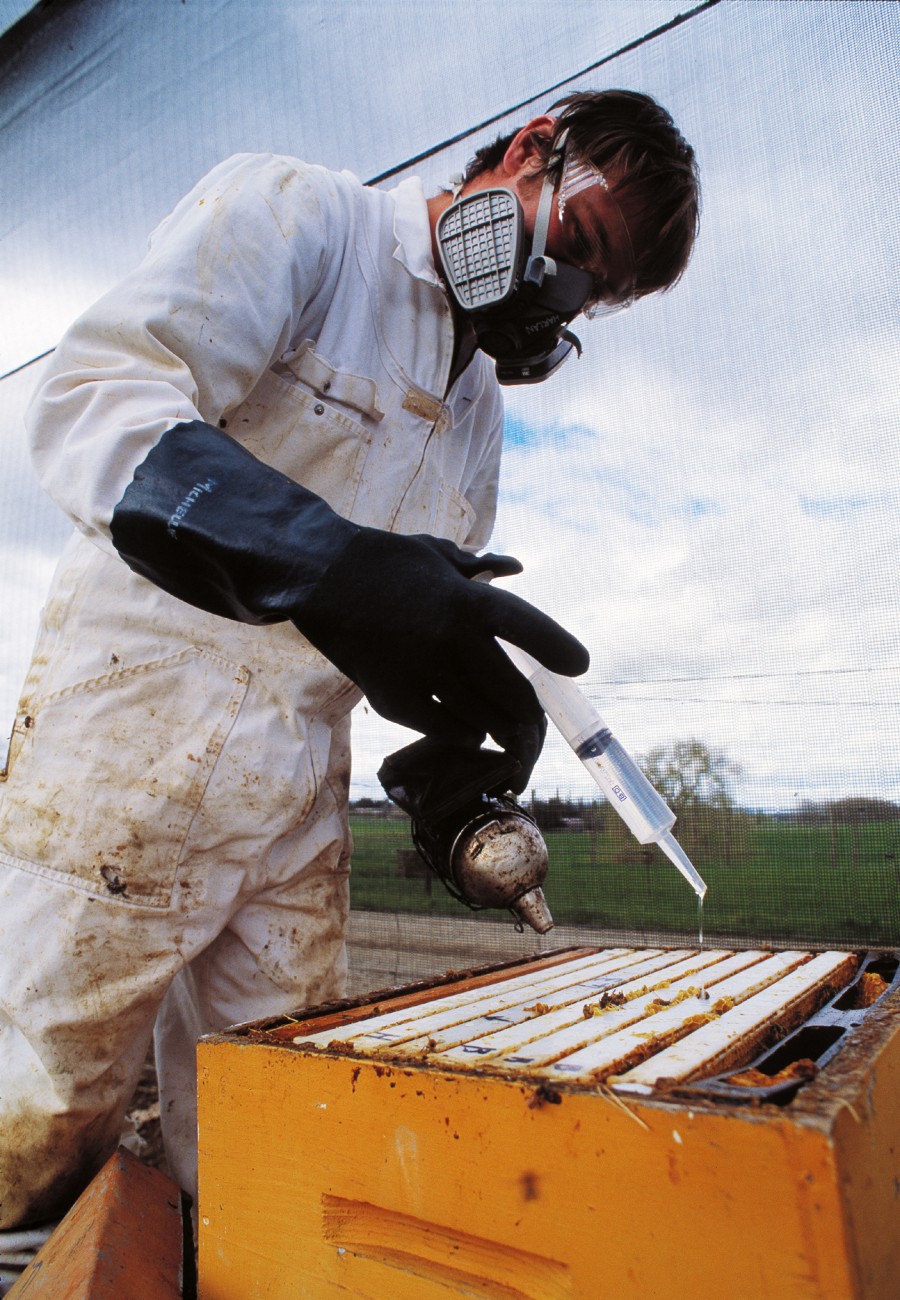 HortResearch’s honeybee unit at Ruakura Research Centre, near Hamilton, has led the way in developing mite-control treatments for New Zealand beekeepers. Here apiary manager Harlan Cox introduces an organic insecticide to a hive as part of a study to determine the best methods of managing the varroa mite.KENNEDY WARNE
HortResearch’s honeybee unit at Ruakura Research Centre, near Hamilton, has led the way in developing mite-control treatments for New Zealand beekeepers. Here apiary manager Harlan Cox introduces an organic insecticide to a hive as part of a study to determine the best methods of managing the varroa mite.KENNEDY WARNE
The government eventually decided eradication was not technically feasible. Varroa was too hard to detect at low levels of infestation, and might have been more widespread than hive testing had shown. With some 150,000 managed hives in the North Island and an unknown number of feral hives, the bee population was basically contiguous, and undetected mite “hot spots” would have compromised any eradication attempt.
The feral honeybee population was especially problematic, and the chance of a grid pattern of poison-bait stations proving more attractive than the bees’ natural food sources was not considered high. Nor was the prospect of widespread poisoning likely to be popular with an increasingly pesticide-wary public.
Some beekeepers still believe MAF dithered and missed its chance to contain the pest, although MAF claims it moved as quickly as the huge scale of the delimiting survey allowed. In the end, government opted for a three-phase management plan: first, treat infected hives; second, restrict movement of bees across a line from south King Country to East Cape; third, form a Varroa Planning Group to assess control options for the long term.
Containment bought a little more time for southern North Island bee keepers, but the mite is now all over the North Island except for parts of Hawke’s Bay and Wairarapa—areas not expected to stay clean for long. It has been spread by beekeepers moving hives from one place to another, by worker bees and drones drifting between colonies and by mite-infected robber bees invading hives.
For the moment, varroa has reached a physical barrier in the form of Cook Strait, and the only way it can reach the South Island is the same way it got into New Zealand in the first place—with a little help from humans. If varroa reaches the South Island—most experts say “when”— beekeepers there will have had three years to learn about the pest and ways to manage it. Unlike their North Island colleagues, they may benefit from government-funded eradication which research has now shown to be feasible—if the mite is detected early enough.
*
DETECTION IS A problem. The mites’ habit of crawling under a honeybee’s overlapping abdominal plates renders them invisible. By the time a beekeeper notices their presence the may have built up to high numbers in the hive.
An adult mite consumes about 0.2 microlitres of bee haemolymph (blood) during its lifetime—a loss that does not seem to hurt a healthy adult bee. The problem lies with the larvae. Varroa breeds and feeds on developing bee brood. As the number of mites feeding on bee larvae climbs, the number of normal adults available to maintain the hive drops. More mites equals lower adult-bee body weight and a higher proportion of adult bees with deformed abdomens and wings and stunted hypopharyngeal glands—the glands that produce royal jelly. Studies have also shown varroa infestation leads to a reduced life span for drones and worker bees, a reduction in foraging, a reduced ability to secrete wax and a reduced tolerance of pesticides.
A colony suffering from these effects is likely to be plundered by stronger robber bees from another hive, and will eventually die. Varroa is also a vector of many honeybee viruses, and acts like a living hypodermic needle, injecting bees with a concoction that could contain acute paralysis virus, chronic paralysis virus, Kashmir bee virus, deformed wing virus and cloudy wing virus, to name but a few. Infection with these diseases may have a more direct impact on a colony than the mite itself.
 Honeybee eggs develop into adult bees over 20 days. A female varroa mite creeps into a cell containing a growing larva on the 8th day. Next day, the cell is capped, and, a couple of days later, the mite lays her first egg, which develops into a male. For the next three or four days, the mite lays an egg each day, but usually by the time the bee is ready to emerge only two or three will be mature enough to survive, and these will be females.COLIN EDGERLEY
Honeybee eggs develop into adult bees over 20 days. A female varroa mite creeps into a cell containing a growing larva on the 8th day. Next day, the cell is capped, and, a couple of days later, the mite lays her first egg, which develops into a male. For the next three or four days, the mite lays an egg each day, but usually by the time the bee is ready to emerge only two or three will be mature enough to survive, and these will be females.COLIN EDGERLEY

Varroa has also had an impact on a disease beekeepers had nearly got under control: the bacterial infection American foulbrood. Unfortunately, parasitic mite syndrome—the name given to a range of abnormal brood symptoms displayed by hives infested with varroa—is easily confused with American foulbrood. Cell caps appear chewed and sunken and often discoloured. Inside a cell, larvae are found slumped against the wall.
According to the state-owned enterprise AgriQuality, the incidence of American foulbrood has jumped since varroa arrived, partly because bee-keepers have been distracted by the new threat but also because they have mistaken foulbrood infection for varroa infestation. Foulbrood-infected hives are burned, so the disease cannot be spread, but varroa-infested hives are treated with chemical or organic insecticides and kept operational.
“We’ve debated which is worse, varroa or foulbrood,” says Murray Reid, national manager of AgriQuality’s apiarist division. “If continuing misdiagnosis means foulbrood is left out in the field, the bee industry could face a big problem.”
To breed, varroa needs bee brood. Adult female mites make the initial strike on a hive, jumping from the transporter bee and invading cells containing either worker or drone larvae before the worker bees have capped them with wax. The mites prefer to feed on drone larvae, and drone cells are eight to ten times more likely to contain varroa. Within four hours of its chosen cell being capped, the female mite emerges from its hiding place in the larval food at the bottom of the cell and starts feeding on the haemolymph of the bee, which is at a development stage known as the prepupa.
The mite then lays five to six eggs, one male and the rest female. There is usually time for only one male and two or three females to complete their development and mate before the bee is ready to emerge. Adult female mites leave the cell when the adult bee emerges, climb aboard a passing bee and repeat the cycle, leaving the male and juvenile females to die in the cell.
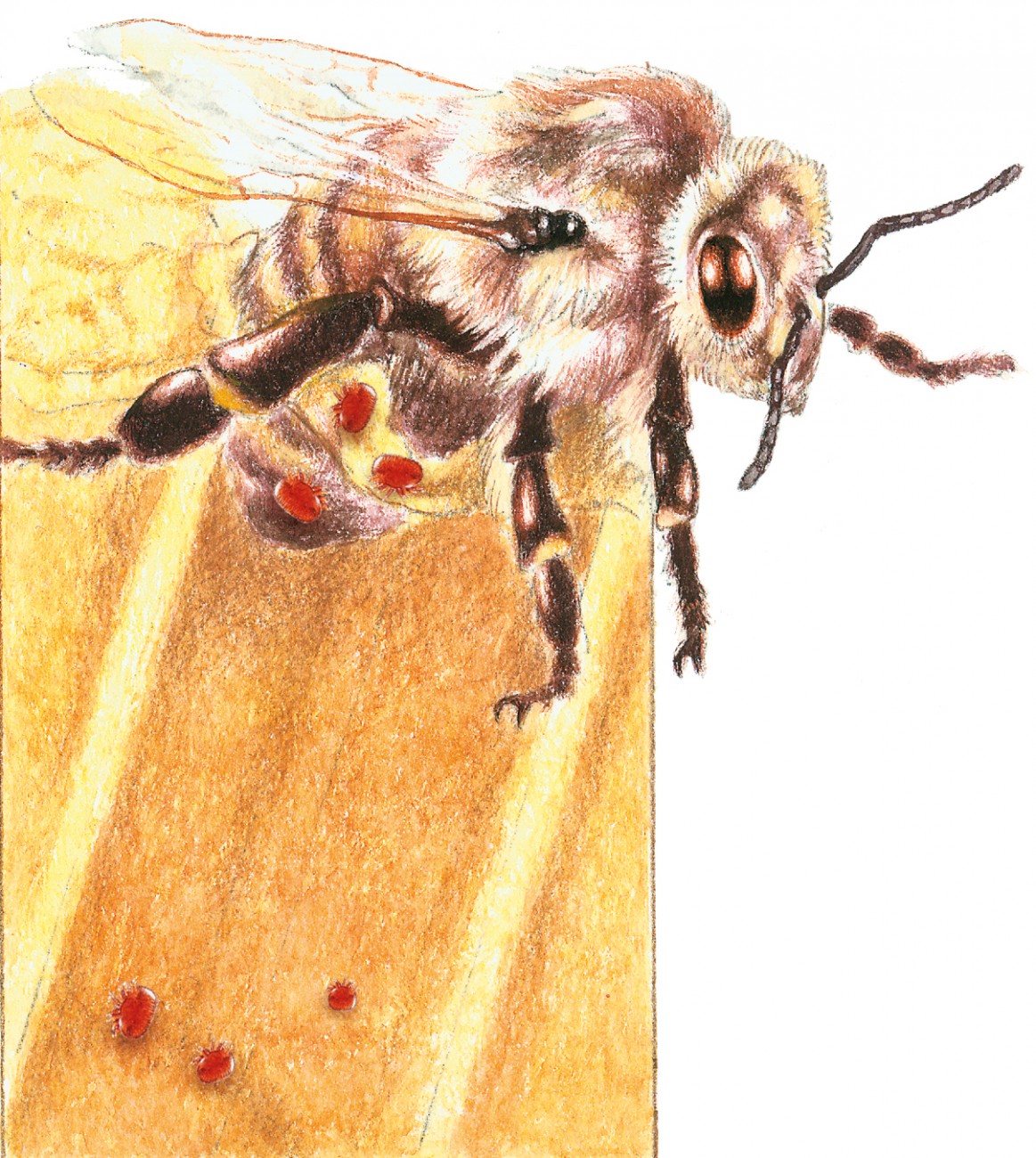 The male mates with them and dies in the cell. Growing mites suck haemolymph from the developing bee and leave the cell attached to it.COLIN EDGERLEY
The male mates with them and dies in the cell. Growing mites suck haemolymph from the developing bee and leave the cell attached to it.COLIN EDGERLEY
While most insects complete only one life cycle per year, varroa is capable of going through one cycle every 15 days. It can reproduce only when there is capped brood in the colony, and reproduces at a much higher rate on drone brood than on worker brood. Mite populations increase exponentially when not limited by the amount of drone brood, and from a single mite a population of 6000 can be reached in as little as 150 days.
With such a snowballing growth rate, small variations in the effectiveness of a control method can have a big impact on infestation levels. MAF’s varroa handbook gives a theoretical example based on a population of 1000 mites. If that population is treated with a pesticide that gives 99 per cent control, it will take 94 days for the population to reach 1000 again, but only 48 and 35 days respectively with control measures that are 90 per cent and 80 per cent effective.
Thus, control measures that take small bites out of mite numbers will not keep infestation levels below economic thresholds for long. They have the added problem of speeding up the development of resistance.
At the Ruakura Research Centre in Hamilton, HortResearch scientist Mark Goodwin and his team have been leading the research work on varroa biology and possible controls. The most effective weapons beekeepers have in their anti-mite arsenal are two pyrethroid-based formulations sold as strips slender enough to fit between the vertical frames of a beehive. Both types can kill nearly 100 per cent of mites in a colony.
After seven or eight years of use, these chemicals have reached the end of their useful life in many countries that have had varroa for a while. The US, for example, has emptied the cupboard of such “soft” chemicals and is now onto “harder,” i.e. less environmentally friendly, organophosphates to which the mites have not yet developed resistance. Goodwin estimates that northern New Zealand may have four years of protection up its sleeve if beekeepers use the strips correctly, but eventually varroa will breed its way around these chemicals.
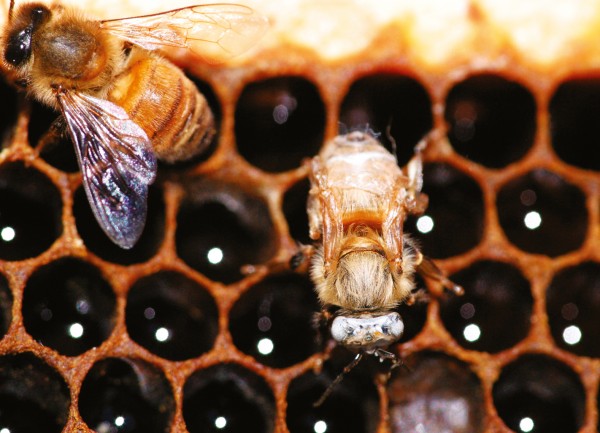 A mite-affected drone (centre), freshly emerged from its brood chamber, looks a sickly creature compared with a normal drone (left). Such individuals are generally less robust and have a diminished life expectancy.HORTRESEARCH
A mite-affected drone (centre), freshly emerged from its brood chamber, looks a sickly creature compared with a normal drone (left). Such individuals are generally less robust and have a diminished life expectancy.HORTRESEARCH
Organic acids and essential oils, though less effective, can be alternated with strips to reduce the mite’s exposure to pyrethroids. Organic beekeepers must rely entirely on these less effective treatments, which puts them at a disadvantage in controlling varroa infestation.
“The two advantages of the organic treatments are lower price and the fact that mites don’t seem to be able to develop resistance to them,” says Goodwin. “I think eventually they will. If you have two bricks and you squash varroa between them, eventually you’ll get a varroa with a thicker skin.”
Most beekeepers believe their best hope of staying on top of varroa is breeding tolerance into their bees. Goodwin shares their enthusiasm for this approach, but is wary of any suggestion of a “silver bullet” for the varroa problem. Breeding programmes will not take care of varroa on their own, he says, not least because bees mate on the wing and it is impossible to stop genetic traits from being “watered down.”
“A queen with mite tolerance will throw offspring with 50 per cent tolerance, which is worth having,” he says. “But the second generation will throw offspring with about 23 per cent tolerance, which is not worth having.”
Ironically, the use of chemicals to keep hives viable is actually taking away the selection pressure for hives to produce queens with good mite tolerance. Yet the genes are here. Some queens have the ability to create hives that prevent the mite from completing its reproductive cycle, says Goodwin. “We don’t understand how it happens, but it’s a natural mechanism that’s already in our bee population. We’ve just got to select for it.”
The continuation of that project, however, is now in doubt. Just days before I visited Goodwin, the government’s research-funding arm, the Foundation of Research, Science and Technology, rejected HortResearch’s application for $700,000 to continue the varroa research.
Justifying the decision, agriculture minister Jim Sutton said the government had spent more than $11 million on varroa, and that affected industries needed to sort out their own long-term responses. National Beekeepers Association president Jane Lorimer says beekeepers are willing to shoulder their share of the funding burden, but has been lobbying other affected industries to try and convince them they should stump up as well.
If no funding is found, Goodwin and his team will have to move onto other projects, leaving beekeepers to face an uncertain future.
*
WITH THE FUNDING knock-back fresh in my mind, I was expecting beekeepers to be a little glum, if not crying into their beers, at a seminar I attended in the Bay of Plenty. Maybe it was the effect of the warm morning sunshine, but as they filed into the Papamoa Primary School hall the mood was upbeat. Serious faces were pulled on briefly to tell me about the $15 million varroa has cost the beekeeping industry and the grave importance of keeping the research going. But the eyes, most of them housed in fairly weathered faces, quickly lit up when talk turned to the upside of varroa. With a strong honey market and increased demand for pollination services, the opportunities are there for the taking. “If I was thirty years younger . . .” was a common refrain.
The fact is, varroa is no longer an unknown, and has proved to be not only manageable but arguably the best thing that could have happened to the industry. Beekeepers have been forced to look closely at their businesses, and those that weren’t running on all cylinders have been found out. An estimated 10 per cent of beekeepers have left the industry, and it is assumed the number of managed bees has fallen by the same percentage.
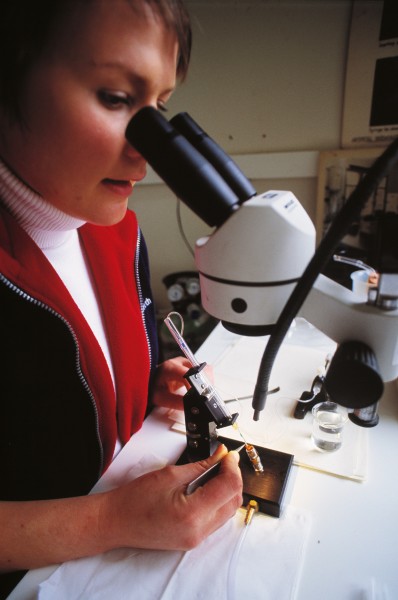 As well as trialling pesticides, HortResearch scientists such as Michelle Taylor have been selectively breeding strains of honeybee with increased mite resistance.KENNEDY WARNE
As well as trialling pesticides, HortResearch scientists such as Michelle Taylor have been selectively breeding strains of honeybee with increased mite resistance.KENNEDY WARNE
The pressure on the bottom line from the extra $20– 30 cost per varroa treatment per hive, plus the time and pressure of treating each hive two to three times a year, is forging a more professional and profitable beekeeper. Most are running fewer hives but running them more efficiently.
On the face of it, the recent boom in world honey prices seems like karmic payback for the early damage done by varroa, and it may be due in part to varroa that the honey market is undersupplied. A poor harvest in drought-stricken Australia and a ban on Chinese honey on account of chemical residues have also contributed to the shortage, but the world loves honey and has been prepared to pay whatever it takes to get it.
“We put up our prices on some lines of honey by 100 per cent last season, and our export markets accepted that,” says Neil Mossop, who harvests and exports honey out of the Kaimai Range. The simple reality is if you’re a serious beekeeper in New Zealand, times are good and likely to get better.
The country produced a record 12,000-tonne honey crop last season and sold it for at least $4 per sweet kilogram. Those lucky enough to have a sought-after bush site on which to place their hives have done even better—much better: UMF (unique manuka factor) honey, which possesses an antibacterial quality, retails on the New Zealand market for more than $25 per 500 g and is finding ready acceptance worldwide.
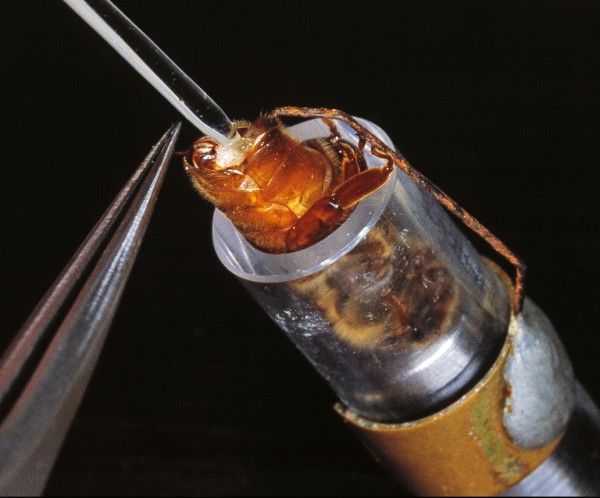 The process involves artificial insemination of queen bees—a task for a steady hand and a good eye. The queens are anaesthetised with carbon dioxide before the procedure.KENNEDY WARNE
The process involves artificial insemination of queen bees—a task for a steady hand and a good eye. The queens are anaesthetised with carbon dioxide before the procedure.KENNEDY WARNE
Api-Med, the company behind UMF, has opened up a new market for apiarists by incorporating the high-phenol manuka honey in wound dressings and selling these to hospitals and clinics both here and abroad. Comvita, a company built on the health benefits of propolis, the honeybee’s hive “mortar,” has bought a 50 per cent stake in Api-Med. “The potential for these products in the medical honey field is huge,” says Comvita CEO Graeme Boyd.
UMF’s discoverer, Waikato scientist Peter Molan, has also found that many New Zealand bush and pastoral honeys have high antioxidant values—another string to the bow of a honey industry now supplying some of the finest dining tables in the world and lining the shelves of Marks and Spencer.
The biggest problem for the beekeeping industry besides the threat of pesticide resistance—is the lack of new blood coming through to replace the older echelon of beekeepers and to meet the shortfall in hives available for pollination of New Zealand’s orchards and farms.
“What we’re all realising,” one old hand told me, “is that varroa is not just a beekeeper’s problem, it’s everybody’s problem.”
*
MANY INDUSTRIES THAT rely on pollination for their success have never really acknowledged the contribution bees have made to their incomes. They’ve never had to, because the bees have always been there, like sunshine or carbon dioxide. True, many crops that reproduce sexually can do so without bees—they are either self- or wind-pollinating—although the “amplifier affect” that insect pollination has on yield would be sorely missed. On the other hand, crops that require cross-pollination produce less than 5 per cent of their potential yield if their flowers are self-pollinated.
New Zealand’s major horticultural industries especially the kiwifruit industry—already manage their pollination requirements by renting hives, and have largely accepted that beekeepers will pass on the extra cost of treating for varroa—around $40 per hive per annum—to them. The rub is that hives for pollination are getting harder to find, and the shortage is likely to get worse.
Rather worse affected are avocado and squash growers, who are among those who have been taking advantage of free pollination courtesy of feral and hobbyist hives—both of which are disappearing fast. Growers of these two crops have already gone to beekeeper groups for advice and to rent hives. Avocado fruit set has been poor in recent seasons, and the industry believes varroa is probably the cause.
A bigger threat to New Zealand, still living on the sheep’s and cow’s back, is the cost of maintaining productive levels of nitrogen across the 9.2 million hectares currently under pasture. When varroa becomes established in the South Island, MAF estimates New Zealand’s pastoral industry will lose more than $230 million a year as farmers are hit with the cost of clover reseeding and additional nitrogen-fertiliser costs.
Lorimer says that while some farmers realise the scale of the threat to their businesses, the pastoral industry as a whole has been slow to see that if it does not help fund research now, varroa will make a bigger dent in wallets in a few years’ time than a contribution would have done today. “Most don’t see the long-term benefits of paying for this research, only the short-term costs. Some do, but others are just applying more urea, which starts a vicious cycle: excessive urea wrecks your clover, increasing the need to apply more urea.” With regional councils already cracking down on fertiliser use because of its impact on waterways, the pastoral industry is on an unsustainable path, says Lorimer.
 The honeybee’s decline creates an opening in the “pollination market” for other insects. However, honeybees leave big shoes to fill. The average honeybee hive contains some 80,000 bees, while bumblebee colonies, such as this one being inspected by Canterbury entomologist Barry Donovan, holds at best 100 bees.KENNEDY WARNE
The honeybee’s decline creates an opening in the “pollination market” for other insects. However, honeybees leave big shoes to fill. The average honeybee hive contains some 80,000 bees, while bumblebee colonies, such as this one being inspected by Canterbury entomologist Barry Donovan, holds at best 100 bees.KENNEDY WARNE
Small-scale agriculture is no less dependent on bees than commercial farms and orchards. The added cost and effort of managing a hive for varroa has seen many hobbyist beekeepers walk away from hives that were used to set fruit on the old plum tree out the back or supply honey for the larder. Some longtime hobbyists felt the effort required to control varroa would take the joy out of being a “bee-haver.” Others, who took the lids off their hives to find varroa had already decimated their colonies, simply walked away from them.
However, as public awareness of the implications of varroa grows, some hobbyists are coming back to bees, while newcomers are learning the beekeeping craft—among them lifestyle-blockers and keen gardeners who miss the buzz of bees in the garden and whose flowering plants and trees have not performed well since the bees disappeared.
Certainly, no one can rely on feral honeybees to take on the pollination duties of the hobby hive. Varroa has all but wiped out feral honeybee colonies, and apart from the occasional swarm from a nearby managed hive that may briefly establish a bush colony, that’s the way it will remain—unless managed bee stocks become tolerant of varroa and slowly rebuild the wild population.
The bee is not just missed in the countryside. Cities were once a Garden of Eden for honeybees, with flowers offering up their wares all year round and a richer variety of pollen and nectar than groomed farmlands. City gardeners may have trouble replacing their free pollinators. It is not economic for commercial beekeepers to put a single hive in a city garden, and there is always a problem with swarming—an aspect of beekeeping which doesn’t fit well in suburbia.
It is hard to envisage a life without bees. Surely every New Zealander has memories of bee-filled summers perhaps the background hum of busy workers in the garden, or the mixed emotions of being stung as a child, knowing that the furry little bee that had left its stinger in you would now die. Once, while walking across a lush dairy farm, I thought I could hear the faint drone of a helicopter on the wind, when suddenly a swarm of bees roared close over my head, leaving me planted on my backside but grinning from ear to ear. Can you imagine a day when a honeybee alighting on a flower at the bottom of your garden is so rare that you call your children to come and see? Sadly, that day is already here.
*
ONE SECTOR OF the community that is shedding few tears over the demise of the honeybee is the conservation-minded. Department of Conservation biosecurity officer Paul Craddock calls feral honeybees “the goats of the insect world,” and says that the varroa incursion—and through it the reduction in honeybee numbers—may prove highly beneficial to native organisms.
Not enough work has been done on the impact of honeybees in New Zealand forests to give conservation scientists the confidence to say what will happen. What they can say is that suddenly an ecological niche has been opened. What pollinators are lining up to fill it?
For years, the draught horse of pollinators, the bumblebee, has put its long tongue and furry body to good use in glasshouses and gardens and on crops such as red clover, to which it is well suited. It is also willing to work in cold, wet conditions that would scare the honeybee back into its hive. But it is slow to reproduce and easily knocked back by a bad winter, so is unlikely to pick up much of the pollination work left undone by feral honeybees.
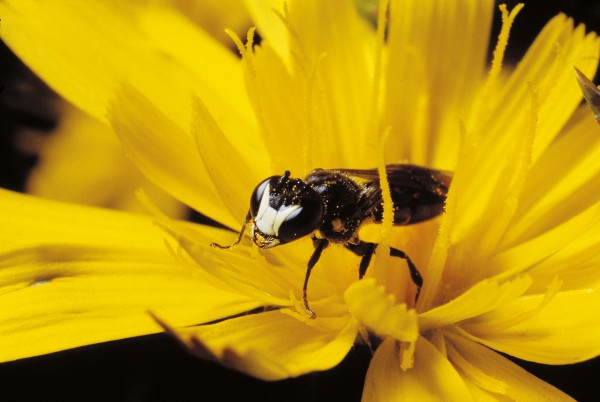 The 40-odd species of native bee lead solitary lives. Just how New Zealand’s pasture-based agriculture and horticulture industries will cope with a reduced honeybee presence remains to be seen.MICHAEL SCHNEIDER
The 40-odd species of native bee lead solitary lives. Just how New Zealand’s pasture-based agriculture and horticulture industries will cope with a reduced honeybee presence remains to be seen.MICHAEL SCHNEIDER
The 40 known native bee species, all solitary insects, which live alone in small holes in the ground rather than in colonies, may prosper. They are not affected by varroa, and some research indicates their abundance has been suppressed in the past by high honeybee numbers.
Christchurch bee expert Barry Donovan, formerly of Lincoln University, is one of the few scientists who have studied native bees. He once put forward the suggestion that the honeybee was getting too much credit for the work it was doing in kiwifruit orchards, and that wind, bumblebees and native bees were making the honeybee “look good.”
Studies made some years ago established that honeybees competed with New Zealand’s native pollinators on some plants, and, when honeybee numbers peaked over summer, easily outcompeted them. In a touch of serendipity, one study recommended that honeybee densities in the wild be manipulated to find out more precisely what native pollinator communities would do in their absence. Nature, it seems, has sent varroa to initiate that experiment.
If you would like to receive the monthly newsletter from Beewhisperer360 drop your email address in the comments section.
